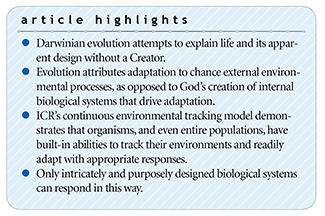 For the past two years, the Engineered Adaptability series of articles has explored ways in which scientific methodology and understanding benefit when engineering principles are applied to how living things function. In the process, we have built a conceptual framework for a design-based model called continuous environmental tracking (CET), which focuses on the mechanisms through which organisms express traits that enable them to closely track changing conditions and adjust accordingly. This final article will take a bird’s-eye view of what the series has presented.
For the past two years, the Engineered Adaptability series of articles has explored ways in which scientific methodology and understanding benefit when engineering principles are applied to how living things function. In the process, we have built a conceptual framework for a design-based model called continuous environmental tracking (CET), which focuses on the mechanisms through which organisms express traits that enable them to closely track changing conditions and adjust accordingly. This final article will take a bird’s-eye view of what the series has presented.
Purposes for the Engineered Adaptability Series
The first goal of the Engineered Adaptability series is to help people understand Charles Darwin’s anti-Designer strategy. Evolutionary theory was developed as a sophisticated anti-design explanation to answer one question: How can creatures that look purposefully engineered to fit their environment have originated apart from the agency of God? In short, Darwin devised an anti-Designer theory. He cleverly replaced heavy-handed declarations such as “there is no God” with a softer anti-design narrative that leads people to draw their own conclusion that a Creator isn’t needed and may not even exist. “No Creator” still arrives at the same “no God” destination, and some Darwin followers affirm to being intellectually fulfilled atheists.
The second goal is to explain why Darwin deliberately focused his theory on the process of adaptation. He envisioned evolutionary development as a long string of adaptations. He astutely recognized that in the battle over evolution’s validity, securing the conceptual high ground depended on controlling the explanation of how adaptation happens. Focusing on the relationship between changing environmental conditions and adaptation, he proposed a revolutionary reversal in causation.1 Darwin visualized random environmental processes that exercise designing agency from outside of organisms, which was in lieu of God’s designing agency as expressed through purposeful self-adjustments originating from within them.
Darwin dubbed his process “natural selection.” The soul of selectionism is the affirmation that the environment exercises agency through volitional selective powers. But although nature is full of living things, nature itself is not alive. It possesses nothing equivalent to a volitional brain that would allow a legitimate application of the word “selection” to it.
Selectionism serves as the illegitimate vehicle Darwinism uses to project agency onto the environment. This fabricated agency allows nature to be seen as a substitute designer in God’s stead. But since environments can’t make bona fide selections, selectionism is fundamentally a misleading, mystical mental construct.2 But by replacing purposeful internal causation with random external forces, Darwin succeeded in changing the structure of modern biological thought into an inherently anti-design externalistic framework.3
Theory matters. Biological observations are interpreted in light of one’s theory, and theory sets research agendas, so a third purpose of this series is to sow seeds for a theory of biological design. One of its core expectations is that there’ll be corresponding system elements between human-designed devices and biological mechanisms that perform similar functions. Thus, since purpose constrains the design of human-engineered complex systems, the theory expects biological systems to also exhibit purposeful design.
Engineers must design all capability into an entity, so biological design theory would be internalistic, meaning that identifiable control systems that are innate to organisms will govern both organismal form and adaptability. Highly regulated internal control systems confer the ability for individuals to relate to each other and to external conditions. Also, explanations of biological phenomena will be restricted to objective engineering causality. This precise way to explain biological functions doesn’t omit any system element between exposure and response, while it specifically precludes personifications of nature in lieu of system elements as agents of change.
A final goal is to move toward an explanation of adaptation as though Darwin had never propagated his theory. A non-Darwinian framework obviously rejects selectionism. ICR’s biological model, continuous environmental tracking (CET), is both design-based and organism-focused. If we begin by assuming that biological functions are best explained by engineering principles, then that change of reference allows us to see biological phenomena differently…and ask fresh questions. Adaptability appears to be the engineered control within organisms that allows them to relate to their environment through appropriate innate self-adjustments. Human engineers use a tracking system to detect and maintain surveillance of a moving target. The Engineered Adaptability series has highlighted diverse mechanisms through which organisms express traits that enable them to similarly closely track changing conditions.

Two very different views of God and creatures become clear. Starting with life emerging naturally from chemicals, Darwinism eliminates God’s engineering agency. Organisms are seen as modeling clay passively driven through time while slowly being crafted by the whims of nature as the environment exercises selective and absolute volitional agency. Nature becomes the substitute god.
The opposing view recognizes God’s designing agency and so conversely sees creatures as active, problem-solving entities endowed with spectacularly engineered innate capacities. Creatures drive themselves through time as they detect, take on, and solve very challenging dynamic conditions through which they continually “fill the earth”…all to their Creator’s glory.
Continuous Environmental Tracking Model in a Nutshell

If engineers were to hypothesize how creatures spread into diverse niches and possibly undergo speciation, they might produce a book titled On the Origin of Species by Means of Continuous Environmental Tracking. Many new discoveries on biological adaptation indicate that it’s not enough to just identify features of design in biological systems. These findings must be fitted into a conceptual framework. CET is a model based on a theory of biological design to explain adaptation. Each following paragraph sums up an article from the Engineered Adaptability series on how to develop an organism-focused, design-based model.
Start with an observation. In this case, as environments change, creatures are soon observed exhibiting suitable self-adjustments. It seems like creatures can track environmental changes. Then look for a corresponding human-engineered mechanism that may explain the observation. For changing conditions, engineers regularly use tracking systems to detect and maintain surveillance of moving targets. Thus, one hypothesis is that creatures use internal tracking system mechanisms as the underlying means of their adaptability.
We find that for most of the documented adaptations, creatures used elements that match well with those underlying the self-adjustable properties of human-designed tracking systems. These are 1) input sensors to gather data on external conditions; 2) internal programming specifying reference values and “logic segments” that compares input data to a reference and selects a suitable response; and 3) output actuators to execute responses. The route from detected condition to specific adaptation runs through these components. The systems exhibit the engineering principle of functional coherence. This means that key elements must be available at the right time, place, and amount to attain function.
These recently described mechanisms are completely internal to creatures. In addition, the way research studies characterize their functions is revealing. In general, they don’t fit scenarios in which genetic variability is fractioned out “trial and error” style through struggles to survive. Rather, these innate mechanisms yield results that are regularly described as “regulated,” “rapid,” often “repeatable,” and, at times, even “reversible”—words that better fit the outcomes of engineered systems.
Sensors play a vital role at the organism-environment interface, even though some research papers omit them in their causal explanations. The way in which sensors are utilized by creatures highlights the purpose-oriented, internalistic nature of engineered design. A fundamental engineering principle is that an adjustable system will have a trigger as an integral part. That trigger—be it mechanical, electronic, or otherwise—will be both a sensor and the initiating element of self-adjusting processes. Creatures respond to only a select few out of a myriad of exposures. Why? First, sensors are exquisitely designed to be sensitive to specific environmental conditions. Second, internal programming specifies for itself which conditions will be signals, cues, or stimuli.
Data collected by sensors are processed by innate logic mechanisms that also direct a response. Human-engineered logic mechanisms imitate the conscious logical intentions of the designer. Basic “if-then” logic is usually achieved by a switching mechanism (e.g., an on-off switch). Many biological switches are incorporated in gene regulatory networks, yielding a type of logical cellular “cognition” used in adaptation. Remarkably, cells possess specific mechanisms to optimize their genome in response to their environment. Consistent with a design-based approach, recent findings indicate that mathematical models and engineering principles could potentially explain all intracellular regulatory networks.
When organisms respond to environmental change, their self-adjustments may be so suitably targeted to the condition that they are often described as predictable. Selectionists will assert that the environment “selected for” the trait. But since a real “selection event” is lacking, the only place selection is happening is in their own minds. A realistic approach recognizes an organism’s programmed “if-then” logic that enables an internal selection of the correct solution to different challenges. This logic-based selection is the outworking of an anticipatory adaptive strategy in which innate solutions precede environmental challenges and are not due to them. Therefore, when diverse organisms converge on similar traits when faced with the same exposure, a reasonable explanation would be that they share the same internal programming for responses.
Three unique mechanisms with a tight correspondence to what a human engineer would design fill out the picture of engineered biological adaptability. When encountering an abrupt environmental challenge, some mechanisms enable a very rapid change in the expression of genes without changing the genes themselves. These are called epigenetic mechanisms. Two characteristics achieve enviable design outcomes. Epigenetics allows a population to “flex” when handling sudden stresses. The early generations rapidly express suitable traits, but then a future generation typically returns to the “baseline” after the stress passes. Engineers must factor time considerations into any adaptable design. Epigenetic mechanisms perfectly fill a crucial time gap right between very rapid physiological self-adjustments and full multi-generational genetic changes.
An exciting research topic focuses on creatures’ internal predictive models that seem to couple information about themselves and their environments in a way that confers “foresight” of future conditions. These anticipatory systems give a vital look-ahead response capability to any tracking system and are a key element of CET. The reality of anticipatory systems refutes evolutionary theory, which holds that adaptations must be “blind” with respect to the future needs of the organism. The details of anticipatory systems are not yet known, but by knowing key elements of human forecasting systems, a theory of biological design can guide scientific research and allow us to make useful predictions.
Finally, this series considered how entire populations rather than just individual organisms might track changing environments. An engineering-based model could see a population as an array of unique problem-solving entities that function like a human-designed distributed computing system. Cutting-edge blockchain technology illustrates how this non-random process might work. This model expects rapid convergence on optimal solutions rather than slow, gradual evolution. Whereas evolutionists emphasize competition in which a few emerge victorious at the expense of the many, the CET population model refreshingly emphasizes cooperation over competition where both the individual and the population are valuable.
This series has covered a lot of territory in exploring the contrasting theories of adaptation. But one of its most important contributions is the realization that applying engineering principles to the way living things function not only provides new insights and better understanding of what we observe, it also opens new opportunities to better appreciate the exquisite design our Creator, the Lord Jesus Christ, has placed in everything He made.
Click here for other articles in the Engineered Adaptability series.
References
- Guliuzza, R. J. 2018. Engineered Adaptability: Darwin’s Anti-Design Doctrine. Acts & Facts. 47 (10): 17-19.
- Guliuzza, R. 2011. Darwin’s Sacred Imposter: Natural Selection’s Idolatrous Trap. Acts & Facts. 40 (11): 12-15.
- Guliuzza, R. J. 2017. Engineered Adaptability: Adaptability via Nature or Design? What Evolutionists Say. Acts & Facts. 46 (9): 17-19.
* Dr. Guliuzza is ICR’s National Representative. He earned his M.D. from the University of Minnesota, his Master of Public Health from Harvard University, and served in the U.S. Air Force as 28th Bomb Wing Flight Surgeon and Chief of Aerospace Medicine. Dr. Guliuzza is also a registered Professional Engineer.










